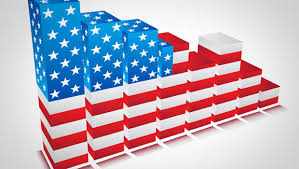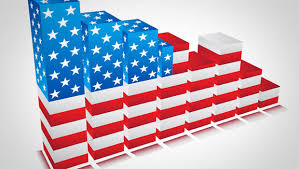
While steady consumer spending and rising business investment pointed to sustained strength in domestic demand, U.S. economic growth slowed sharply in the fourth quarter as a plunge in shipments of soybeans weighed on exports.
In its first estimate of fourth-quarter GDP, the Commerce Department said on Friday that the gross domestic product increased at a 1.9 percent annual rate. In the third quarter, the economy grew at a 3.5 percent annual rate.
A rebound in business investment on equipment after four straight quarterly declines and a surge in home building spending were masked by the slowdown.
As it struggled with weak oil prices, a strong dollar and efforts by businesses to reduce a large inventory overhang. the economy expanded 1.6 percent for all of 2016, the worst performance since 2011.
Largely on the back of a plan to cut taxes, reduce regulations and increase infrastructure spending, U.S. President Donald Trump vowed during last year's election campaign to deliver 4 percent annual GDP growth.
"The details of the report were quite sound. The U.S. economic expansion got its mojo back and the momentum appears to be carrying over into 2017," said Scott Anderson, chief economist at Bank of the West in San Francisco.
Last quarter there was a rise of a 2.8 percent rate in a measure of private domestic demand. An outsized jump in soybean exports in part drove economic growth in the third quarter.
According to analysts, in both the third and fourth quarters,, excluding soybeans, GDP increased at about a 2.7 percent rate.
Because of cheaper oil and the robust dollar undercut business spending, there were weak corporate profits in the first half of 2016. Companies placed fewer orders with manufacturers due to the inventory correction. The economy grew 2.6 percent in 2015.
The economy appears set for continued expansion with oil prices rising and global demand picking up. Starting to lift wages and supporting consumer spending is a labor market at or near full .
Trump’s promises have been embraced by consumers, businesses and investors, although he has offered little detail on his economic policy. While the U.S. stock market has rallied to record highs, consumer and business confidence have soared.
Consumer sentiment hitting a 13-year high in January, showed a separate report on Friday.
"While the size and the timing of the tax cut, infrastructure spending and regulatory rollback are uncertain, economic growth could double during the second half of the year," said Sung Won Sohn, an economics professor at California State University Channel Islands in Camarillo.
However a risk to the economy is posed by sustained dollar strength and uncertainty over the Trump administration's trade policy.
Reversing the 10 percent increase notched in the third quarter, in the fourth quarter, exports fell at a 4.3 percent rate. Noting the biggest since the first quarter of 2015 was the fourth-quarter drop in exports.
On the other hand, imports into the U.S. increased at their quickest pace in two years driven by rising domestic demand. And noting the biggest drag since the second quarter of 2010, the trade deficit sliced 1.70 percentage points from GDP growth.
(Source:www.reuters.com)
In its first estimate of fourth-quarter GDP, the Commerce Department said on Friday that the gross domestic product increased at a 1.9 percent annual rate. In the third quarter, the economy grew at a 3.5 percent annual rate.
A rebound in business investment on equipment after four straight quarterly declines and a surge in home building spending were masked by the slowdown.
As it struggled with weak oil prices, a strong dollar and efforts by businesses to reduce a large inventory overhang. the economy expanded 1.6 percent for all of 2016, the worst performance since 2011.
Largely on the back of a plan to cut taxes, reduce regulations and increase infrastructure spending, U.S. President Donald Trump vowed during last year's election campaign to deliver 4 percent annual GDP growth.
"The details of the report were quite sound. The U.S. economic expansion got its mojo back and the momentum appears to be carrying over into 2017," said Scott Anderson, chief economist at Bank of the West in San Francisco.
Last quarter there was a rise of a 2.8 percent rate in a measure of private domestic demand. An outsized jump in soybean exports in part drove economic growth in the third quarter.
According to analysts, in both the third and fourth quarters,, excluding soybeans, GDP increased at about a 2.7 percent rate.
Because of cheaper oil and the robust dollar undercut business spending, there were weak corporate profits in the first half of 2016. Companies placed fewer orders with manufacturers due to the inventory correction. The economy grew 2.6 percent in 2015.
The economy appears set for continued expansion with oil prices rising and global demand picking up. Starting to lift wages and supporting consumer spending is a labor market at or near full .
Trump’s promises have been embraced by consumers, businesses and investors, although he has offered little detail on his economic policy. While the U.S. stock market has rallied to record highs, consumer and business confidence have soared.
Consumer sentiment hitting a 13-year high in January, showed a separate report on Friday.
"While the size and the timing of the tax cut, infrastructure spending and regulatory rollback are uncertain, economic growth could double during the second half of the year," said Sung Won Sohn, an economics professor at California State University Channel Islands in Camarillo.
However a risk to the economy is posed by sustained dollar strength and uncertainty over the Trump administration's trade policy.
Reversing the 10 percent increase notched in the third quarter, in the fourth quarter, exports fell at a 4.3 percent rate. Noting the biggest since the first quarter of 2015 was the fourth-quarter drop in exports.
On the other hand, imports into the U.S. increased at their quickest pace in two years driven by rising domestic demand. And noting the biggest drag since the second quarter of 2010, the trade deficit sliced 1.70 percentage points from GDP growth.
(Source:www.reuters.com)





